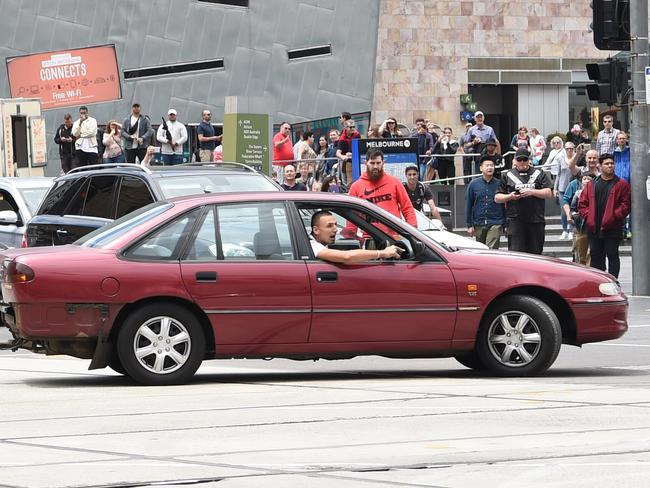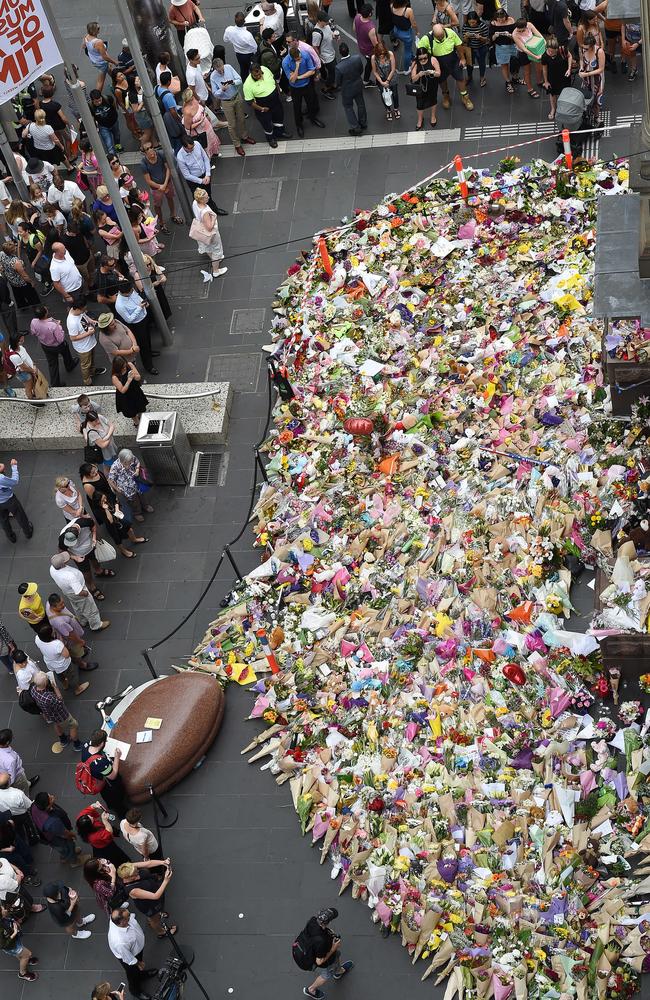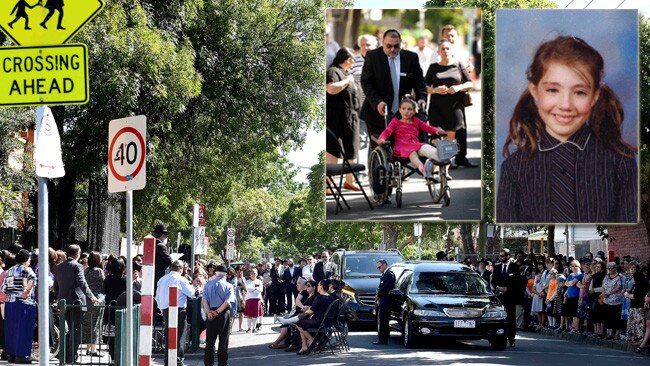Horror in the city: How an ordinary Friday in Melbourne’s CBD turned to tragedy
IT’S Friday in Melbourne’s CBD. Cars toot, shoppers saunter, workers rush back from lunch. Just like it was a week ago, moments before the unimaginable unfolded.
VIC News
Don't miss out on the headlines from VIC News. Followed categories will be added to My News.
- Thalia: ‘She never ever wanted to hate people’
- Horrifying footage of Bourke St terror
- Doyle warns of Bourke St Fund scammers
MELBOURNE woke last Monday to the tale of Gary Oke.
One more step, he said, and he would have been one of the bodies that “just went everywhere”, “flying in the air”.
Oke might now be eulogised as a kind and thoughtful soul. Instead, he is a victim, if not a statistic.
The RACV Club worker was recalling the final moments of Thalia Hakin, the 10-year-old who died near a bike rack in Bourke St.
Oke spoke of open eyes and blood and defibrillators. He tried everything, he said, and achieved nothing, except to be with a dying girl when her family could not.
Finally, almost as a mercy to every listener, Oke got to the silver blanket that was placed over Thalia.

“It took me a while to come to terms with what happened at the time,” he said, before expressing his disbelief — a “beautiful little girl just out for the day” with her sister and Mum.
The interviewer, 3AW’s Neil Mitchell, sounded like a counsellor, Oke his patient. Yet Mitchell, a hardened news man, shed tears during the prerecorded interview.
He had considered editing out the jolting detail of Thalia’s death.
Instead, he warned Thalia’s family against listening — indeed, he could barely listen himself when the interview aired.
This was Oke’s story. This was what happened on Bourke St, and we had to know what happened.
PM’S PLAN TO PREVENT ANOTHER BOURKE ST TRAGEDY


Today, there were car toots and the tickers of the pedestrian lights on Bourke St.
Lunchers and shoppers streamed in waves, from the music of the mall to the shadows of commerce on the rise to the west.
Lou Bougias, a cabbie, who at 46 was sitting at “his” rank of six years outside the RACV Club, and wondering how to give up cigarettes — again.
It was much as it had been the previous Friday, until a car roared and people flew through the air.
Yesterday, a regular client spotted Bougias and shook his hand. “Saw you on the news,” the client said. “Didn’t surprise me at all.”
Eight days ago, Melbourne Lord Mayor Robert Doyle had gasped at the “violent speed” of a maroon Commodore from his perch above Swanston St. First, “a twisting left hand turn”, then a “wrenching right”.
He knew then, before the first person was struck, that this was a “profound moment in the psyche of the city”.
Panic and broken bodies
No one was ready. Oke’s story, and so many others like his, would strip away the abstractions and reduce events to what they were: panic and broken bodies. The details of the Commodore’s killing spree have been keenly documented: more footage is certain to emerge. What happened is bathed in confusion and the odd hero, such as Oke and Bougias, who jumped to help while many bystanders understandably shrunk into shock.
Doyle has been struck by the outpouring of “love”. His eyes moisten whenever he approaches the blooms in Bourke St, which was often this week, where a tissue box marks the spot for the condolence books.
His face has doubled as a city’s emblem of pain and resolution, his shifting expressions of intensity and rawness of a kind avoided by most modern politicians. He knows the healing will hurt. And that those who grieve — as well as the city itself — need more than gestures.
Jess Mudie’s nan is owed. So is Zachary Bryant’s big sister, as well as Nathalie Hakin, the mother who woke in hospital on Wednesday morning with instant recall: “Some maniac hurt my family.”
Premier Dan Andrews appears to know this, too. In offering his support and prayers last Sunday, he conceded that it “isn’t enough”.



DIMITRIOUS Gargasoulas, 26, has been charged with five murders.
Accounts of his whereabouts and interactions were published before he was charged. No evidence suggests that authorities had any direct warning of what would happen in Bourke St.
Their responses will be weighed at an inquest headed by the State Coroner Justice Sara Hinchey. She will sort the available facts, from the squiggled markings that lay fading in Bourke St days after the carnage, to policies and procedures.
She will hear testimonies of witnesses, emergency services at the scene, and their superiors. Yet we have already been led to assume some systems were broken: everyone from Premier Andrews down embraced a consensus of disbelief while the injured still lay in emergency rooms.
Victoria’s bail system was faulty, it was agreed. Stories abounded of bail travesties this week, such as that of Adrian Bayley.
He was on bail — after he appealed a three-month sentence for seriously assaulting a man, while on parole for a string of rapes — at the time he killed Jill Meagher in 2012. Police did not oppose his bail (and the parole board did not cancel his parole).
A more everyday snapshot is the case of the two drug users with violent histories who not long ago assaulted a Big Issue seller.
They were identified and arrested at a city theatre. The next day, they were back at the same city theatre — fully processed recipients of bail.
By last weekend’s end, after a Sunday Cabinet meeting, the bail system had been “reformed”. The volunteer bail justices were out — “on call” magistrates and later, a night court, were in. A review headed by former Supreme Court judge Paul Coghlan would make recommendations by early April.
An engine roaring, then repeated bangs
Then there are the final hours of the Commodore to consider.
Its journey ended in gun shots and a tangle of pram parts.
It began with a stabbing in Windsor the previous night. Footage of its travels, from a driver’s rant on a breakfast TV report in Windsor, to burnouts at Melbourne’s most recognised intersection, will extend to CCTV from Bourke St shops.


The back bumper of the Commodore was missing: it seemed difficult to miss given its age and distinguishing features. “You don’t see these cars around much anymore,” says one witness, who spotted the car — trailed by two unmarked police cars — at a Port Melbourne intersection.
The car’s journey seemed largely unhampered by official controls.
That same witness reports later seeing the police cars trawling Port Melbourne side streets, as if they had lost the Commodore.
The car stopped and started in the hours before, in what now reads as an aimless and spluttered journey: Windsor, Clarendon St in South Melbourne, Docklands, Yarraville. After that, the car headed through Port Melbourne into the city.
It seems, if another witness account to the Herald Sun is accurate, that the police may have lost sight of the Commodore about 11.40am, when a woman was released from the car.
Some reports have said the woman got out on the Bolte Bridge, but this witness account — cross referenced with the chronology of other witness reports — appears to muddle that scenario.
The witness was sitting at lights in heavy traffic near the South Wharf DFO when he noticed officers approaching from a police van and an unmarked police car. Behind him, he heard an engine roaring, then repeated bangs — metal on metal.

The driver of a red Commodore had rammed cars forward and back to open a gap. It drove past the witness, who eyeballed the driver. The Commodore drove on the wrong side of the road, then cut back to take a West Gate Freeway entrance.
The witness says police stared at one another, as though stunned, before an officer took off in pursuit after about 15-20 seconds.
The chase was not called off, he alleges: rather, the police appeared to lose the car in the driver’s extraordinary escape. Soon afterwards, the woman later identified as being in the car was walked down the road, cable-tied.
Matt Kitchin, of the Herald Sun, watched the car speed down the wrong side of Williamstown Rd in a northerly direction about five minutes later, at about 11.45am.
The car, missing its back bumper, cut back into the left side of the road, before again driving down the wrong side of the road.

A pedestrian stood at the intersection of Anderson Rd, her arms raised in shock. What surprised Kitchin was the apparent absence of trailing police cars.
Mapping suggests the driver then turned left, and left again, to park in Drew St, Yarraville. According to home renovator Trent Schmidt, speaking to The Australian, the driver left the engine idling for about an hour and engaged him in odd conversation about the sun being a comet and a secret bunker at the state library.
The driver allegedly boasted that he would be on the news that night.
A police chopper roared into view about five minutes after Schmidt called 000, he said, prompting the driver to speed off. The car was spotted soon afterwards doing burnouts at Flinders St and Swanston St. Here, it was easier to track, but harder to stop, given the crowds and concerns for public safety.
We need the facts
If Melbourne is to come to terms with the deaths of five people and injuries to dozens more, it needs to know how a car came to be driven like a weapon down Bourke St.
It needs to know what happened before the car did burnouts at Melbourne’s busiest meeting point, or about 120 metres from the nearest police station.
It needs facts.
It appears the people have already decided that some of the institutions that they are supposed to trust in have — once again — failed them.
The answers, as NSW discovered after the Lindt cafe siege, are bound to be uncomfortable. In Sydney, a random act by a crazy man invited questions about bail policy and police procedures that led witnesses to the strangest of logics on the stand. A police commander told a coroner’s inquest that the gunman had “the same rights” as his hostages. The family of Tori Johnson, the victim executed after 16 hours, did not see it the same way.
Bourke St and Lindt can already be linked, and not only because Melbourne City Council has contacted Sydney about its memorialisation. The crime scenes were both soft targets in the city’s heart. The victims in both cases could have been anyone. Why some lived, and others didn’t, will haunt some survivors. Former police commissioner Christine Nixon once endured some damning inquiries; she must now live with the memories of an upturned pram and a shrieking mother.

There are the Messianic undertones in each case. Each suspect man seemed to crave an audience: modern technologies lent them a voice that their message did not warrant.
And in both cases, the suspects were under intense scrutiny in the hours before terrible things happened.
Perceptions about Bourke St have naturally coalesced.
The label of a police force that has become too “risk averse” appears to have stuck: events have certainly fired public contempt, and discord from the ranks, if social media is any guide.
Perceptions and facts will clash and blend, but it appears the people have already decided that some of the institutions that they are supposed to trust in have — once again — failed them.
“I think there was grief quite properly as a first reaction,” Doyle says. “How am I going to deal with this? But underneath that there is an anger about how did this happen. Inside that question is the further question — how could this have been prevented?”
Chief Commissioner Graham Ashton has said that he is “rock solid” in his support for his police officers’ decisions. Some police do not share their leader’s public show of confidence. They include some of the officers who made the decisions.
Ashton has spoken of the natural tendency to second-guess operational decisions. “I am satisfied from my perspective — I emphasise my perspective — all decisions that our officers made were in the interests of trying to provide community safety,” he said the day after Bourke St.
Doyle, too, preaches calm in the wait for necessary facts. “There is a world of difference between sitting back a week later and looking at CCTV footage and having to, on the spur of the moment, make any one of 10 or 12 decisions, any of which can have awful outcomes,” he says.

Yet even bystanders are wondering if they might have stopped the deaths. The suspect turned up at Dog’s Bar, a popular nightspot in St Kilda, twice on the night before Bourke St. In a rage, he swept bottles from tables on the terrace. About 14 blokes were on hand at the time, and the manager later pondered how events may have been different if they had subdued the suspect on the spot.
The South Wharf witness, who won’t be named publicly, visited the Bourke St memorial this week. He spoke with a man who had watched Jess Mudie, 22, die.
The witness did not sleep for three nights after Bourke St. He thought the police should have acted more decisively at South Wharf, a judgment ultimately reserved for a higher authority. But ought he have done more himself?
“I could have pulled in front of him,” he says, ‘boxed him in.”
“But I thought, ‘no, I’ve got kids in the back’. If I had been in the work van I would have done it.”
Broken hearts and lives led
LOU Bougias is on a “de-stress” walk when we catch him late on Thursday.
It’s been a difficult few days, he says, though lunch with some of the police officers at the scene had been “healing”.
Henry Dow, another bystander who outed Bougias’ good deeds on Facebook came along — “he looked like he needed to have a chat with some older brothers”.
Bougias took charge in the moments after the car flew past, skittling five or more pedestrians. He tended to a woman and coaxed trembling bystanders to help the injured.
Dow assumed Bougias was an emergency services veteran.
“I know how it happened,” Bougias says. “I saw this bloke. He was two-and-a-half feet away from me at the closest point. I didn’t see his face but I saw his gaze.”
Bougias hasn’t visited the counsellors — not yet anyway.
But it sounds like he will not be troubled by questions of whether Bourke St could have been avoided. He slept on Thursday night without alcohol for the first time since Bourke St.
On Friday, a week almost to the minute since Thalia Hakin was struck, he points out where she died then declares that it is time for him to try and “move on”.
“Whether it happened that Friday, or a month in the future, or two months in the past, it was still going to happen,” he says.
Is he angry? “No”
Both Bourgias’ poise in crisis and his calm framing of events sets him apart. As he immersed himself in work yesterday, victims of crime campaigners held banners asking “Why?” at the largest Bourke St memorial.
Throughout the week, Andrews spoke of broken hearts.
A slow drip of information filled the collective grief: ages, then names, then photos, then tales about lives led.
The killed were young: they leave behind parents and siblings who may never make sense of their losses.
Bourke St broke our systems, too, or at least revealed their fault-lines. Major crimes have a habit of doing this in Victoria. Think of Jill Meagher’s death.
Or Masa Vukotic’s. Both women were killed by deranged men whose liberty at the time relied upon oversights in the justice system. Last Sunday, moments before Prime Minister Malcolm Turnbull explained that safety was the highest priority of any government, someone told him that we needed tougher laws. The timing seemed about right.
Doyle, a former state government minister who is also chairman of the Royal Melbourne Hospital, has considered the complexities since Bourke St.
He knows that popular politics do not always equate with good policy. Areas as jumbled and overlapping as mental health, substance abuse and the justice system have never produced neat solutions.

When mentally ill people create a safety risk, how do we manage them? Should we consider a co-ordinating role that combines the complex needs of volatile individuals?
A siloed approach opens cracks that certain individuals, almost inevitably, expose by hurting the innocent. Perhaps recent events will inspire a more holistic approach; at least Doyle hopes so.
“I think this situation surely has to generate as much change to legislation, to practices, to government departments and bureaucracy, as Hoddle St did,” says Victims of Crime Commissioner Greg Davies.
“There were seven people killed and 22 injured in Hoddle St. It’s not that different. It’s not abstract, it’s not removed, it’s the Bourke St Mall, and everyone in Victoria knows what the Bourke St Mall is and everyone in Melbourne has been there.”
He speaks of the victims who go unnoticed, those who do not count in official tolls. There may be thousands of tortured souls.
Such as Doyle, who got out of town this weekend, with his wife and young child and the “awful feeling in his gut that it could have been worse”.
Such as Tony Hakin, whose daughter Maggie sat in a wheelchair in the front row for her sister’s funeral on Wednesday.
Such as Gary Oke.
Such as the person who left flowers at the Queen St-Bourke St intersection this week: “I’m sorry I was so useless and I froze & didn’t help you xoxo”.



